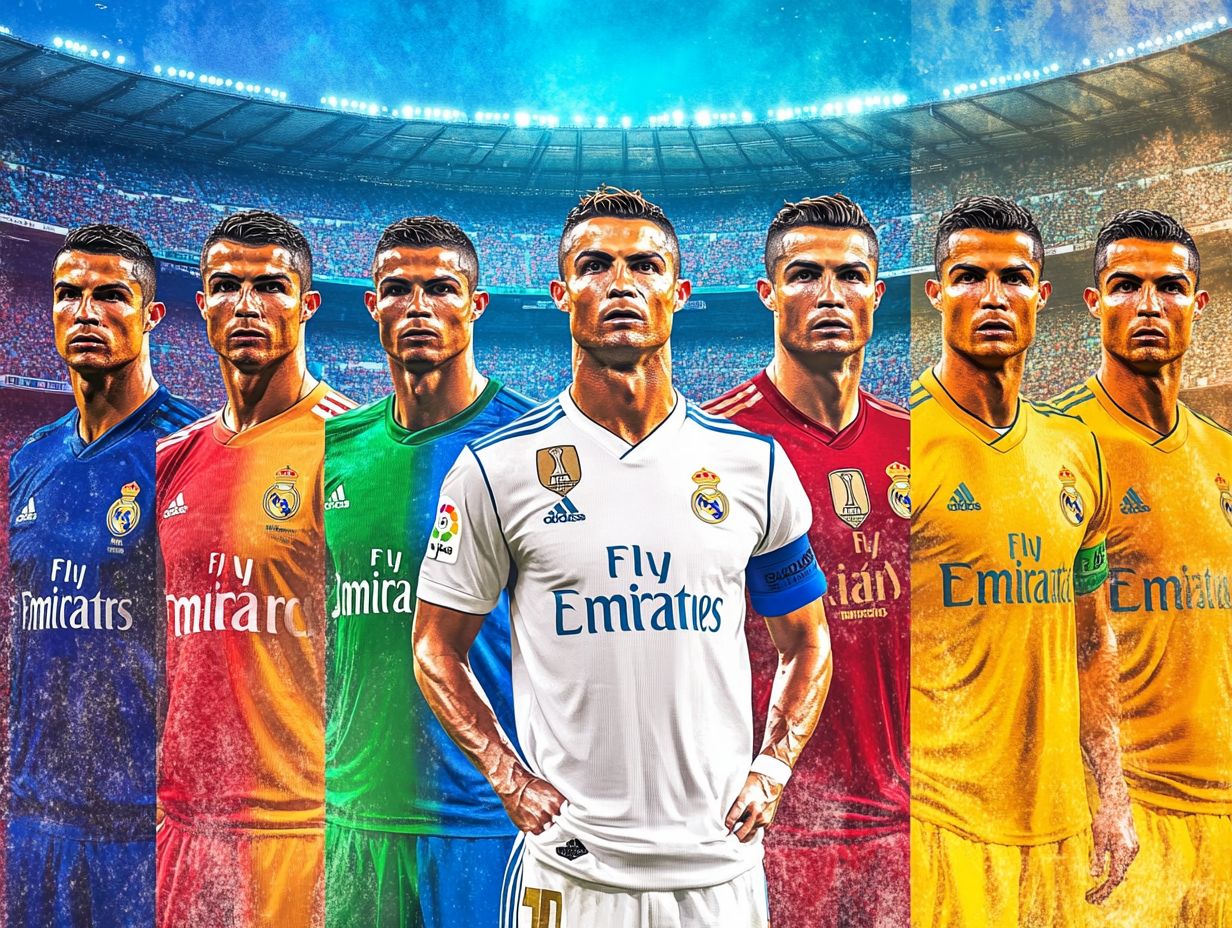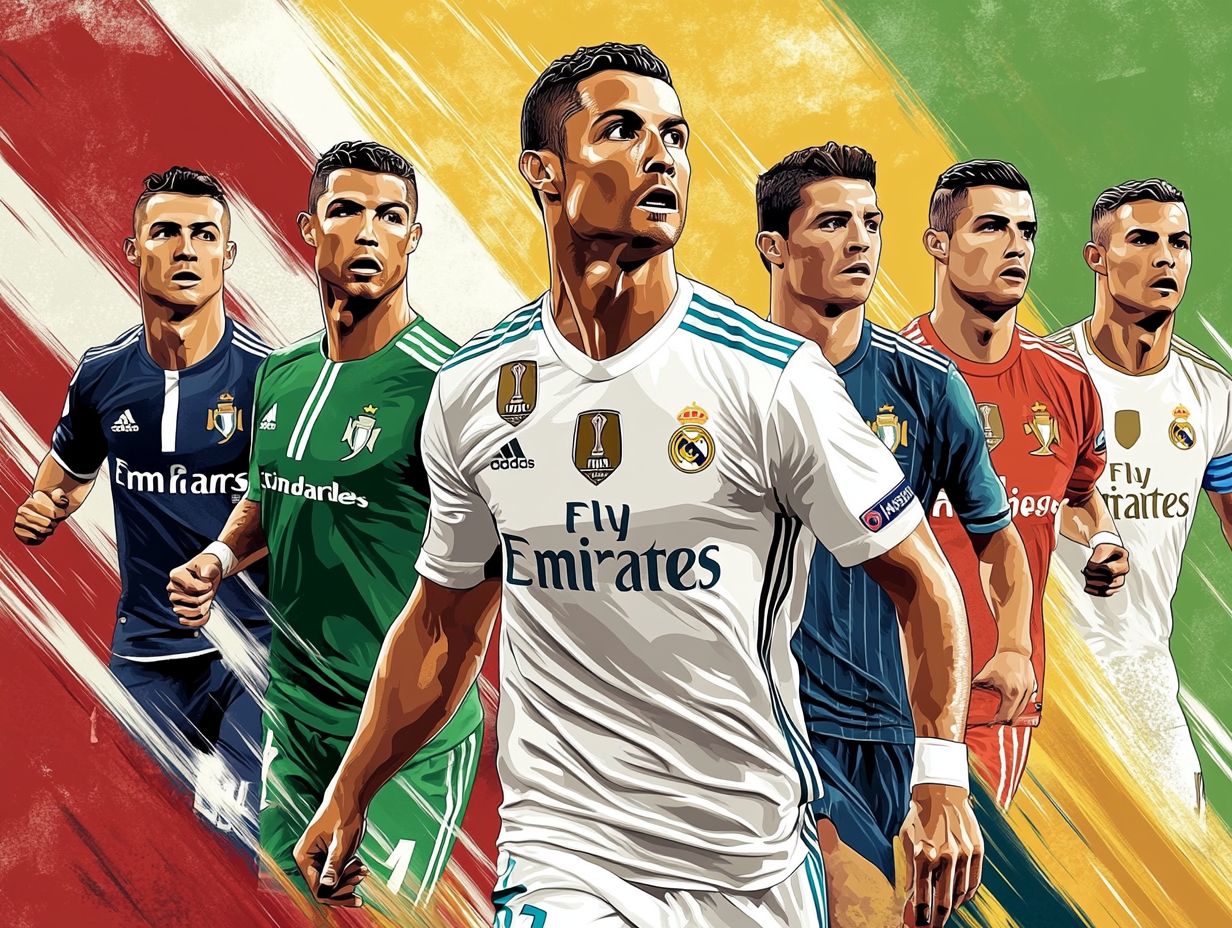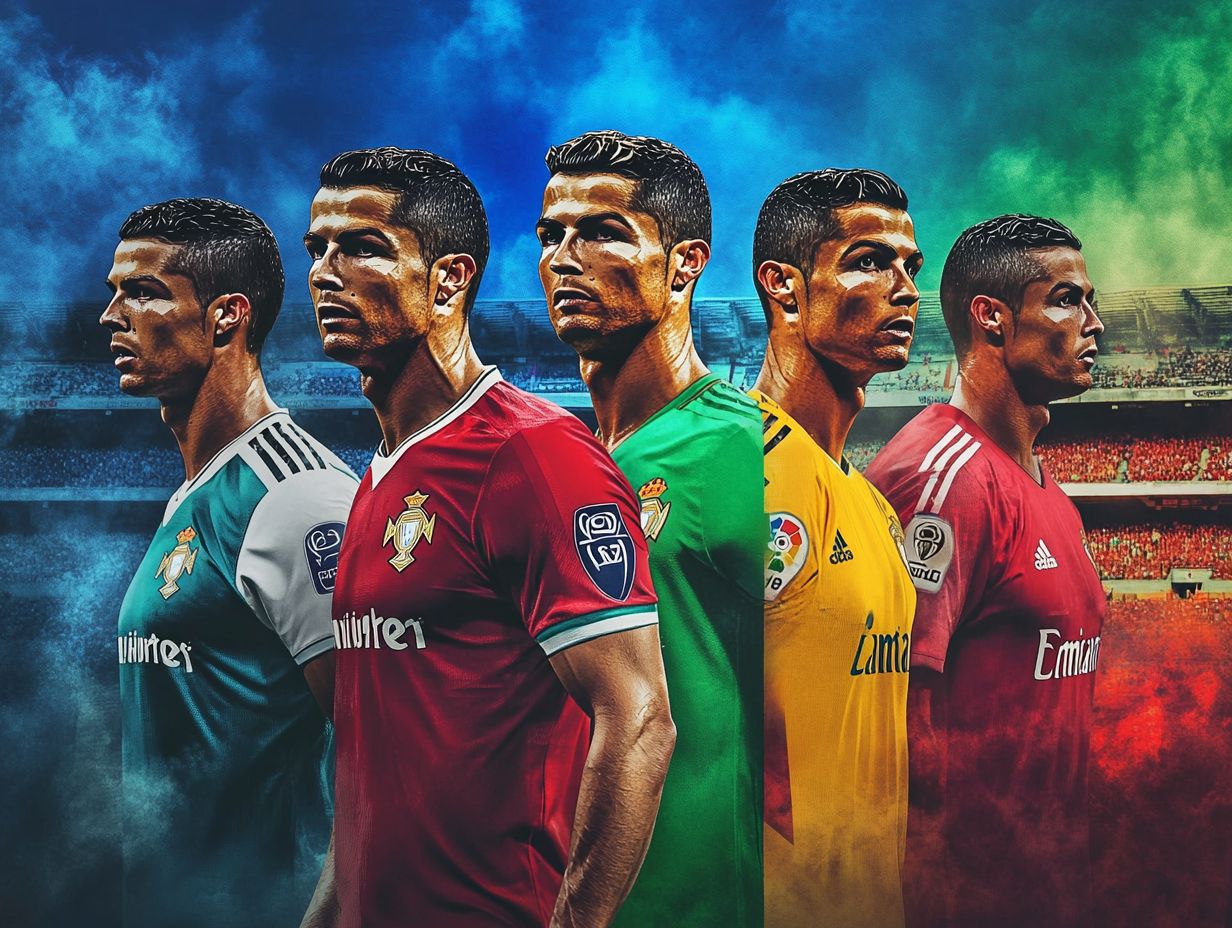Cristiano Ronaldo’s transfer history is a captivating journey that reflects not just his evolution as a player, but also the shifting dynamics of global football.
From his beginnings at Sporting Lisbon to his high-profile moves between clubs like Manchester United, Real Madrid, and Juventus, each transition has left a mark on the teams involved.
This piece explores Ronaldo’s club changes, examines their impact on his career and the respective clubs, and compares his transfer saga to that of other footballing greats.
Join us as we unravel the story behind one of football’s most iconic players and the legacy of his moves on the sport.
Overview of Cristiano Ronaldo

Cristiano Ronaldo is a distinguished Portuguese footballer who has established himself as one of the greatest players in the history of the sport, characterized by an impressive career that commenced at Sporting Lisbon. His journey has been marked by remarkable achievements, including multiple Ballon d’Or awards and leading Portugal to victory in Euro 2016, which exemplifies not only his exceptional talent but also his resilience and determination on the international stage.
From his early days in the youth academy, where his extraordinary skill and dedication set him apart, he quickly garnered the attention of scouts, facilitating his move to Manchester United. During his tenure at the club, he evolved into a global superstar, accumulating numerous trophies, including three Premier League titles and a prestigious UEFA Champions League trophy.
His subsequent transfer to Real Madrid signified a pivotal chapter in his career, during which he not only became the club’s all-time leading scorer but also experienced significant success in both domestic and international competitions. Following his time in Spain, his impactful performances continued at Juventus and later during his return to Manchester United, demonstrating an unparalleled commitment to excellence throughout his illustrious and diverse career.
Transfer History
Cristiano Ronaldo’s transfer history represents a compelling narrative that highlights the evolution of player movements within football. It commenced with his transfer from Sporting Lisbon to Manchester United in 2003 for a fee of approximately £12 million, marking the beginning of an illustrious career in the Premier League.
His subsequent transfers have significantly influenced both his career trajectory and the clubs he has represented, particularly notable are his record-breaking transfers to Real Madrid and Juventus, each setting new benchmarks in the football transfer market.
From Sporting Lisbon to Manchester United
Cristiano Ronaldo’s transfer from Sporting Lisbon to Manchester United in 2003 represented a pivotal moment in his career, as he joined the Red Devils for a transfer fee of approximately £12 million, making him one of the most expensive teenagers in football at that time. This move not only initiated his ascent to global stardom but also highlighted the increasing emphasis on developing young talent within the sport.
During his tenure at Sporting Lisbon, Ronaldo displayed remarkable skills and exceptional performance with the youth team, which captured the attention of scouts from across Europe. Manchester United, under the astute management of Sir Alex Ferguson, recognized his potential and acted swiftly to secure his signature. Ferguson’s mentorship proved essential in refining the young footballer’s abilities and instilling a strong work ethic that would later characterize his career.
The impact of this transfer extended well beyond the clubs involved; it signaled a significant shift in the footballing landscape, underscoring the importance of investment in youth and the substantial increase in the commercial value of top talent. Both clubs notably reaped benefits from this transaction, with Sporting Lisbon gaining financial leverage while Manchester United capitalized on the emergence of a superstar.
Manchester United to Real Madrid
The transfer of Cristiano Ronaldo from Manchester United to Real Madrid in 2009 for a remarkable fee of £80 million marked not only a record transaction at the time but also a pivotal moment in football history, establishing a new benchmark for player valuations. This transfer provided Ronaldo with the opportunity to demonstrate his exceptional talents on a more prominent stage, resulting in multiple Champions League victories and numerous individual accolades during his tenure with Los Blancos.
The decision to move was significantly influenced by the prestigious environment of La Liga and the enticing prospect of advancing his career under the strategic leadership of Florentino Pérez. During his time at Manchester United, Ronaldo had already attained considerable success, including three Premier League titles and the prestigious Champions League trophy in 2008.
The allure of Spain and the opportunity to continue setting records alongside Real Madrid’s storied legacy proved irresistible. This transfer not only transformed the financial landscape of football but also had a profound impact on the dynamics of both clubs. Manchester United faced the challenge of replacing a pivotal figure, while Real Madrid embraced a superstar destined to become one of their greatest players in history.
Real Madrid to Juventus

Cristiano Ronaldo’s transfer from Real Madrid to Juventus in 2018 for a reported fee of €100 million represented a pivotal moment in the football landscape, as he became the most expensive player in Serie A history. This transfer not only illustrated Ronaldo’s pursuit of a new challenge but also emphasized Juventus’ ambition to restore their prominence in European football through the acquisition of elite talent.
The arrival of such a distinguished player notably enhanced the club’s profile and served as a catalyst for their aspirations for success in both domestic leagues and on the continental stage. Throughout his tenure, Ronaldo consistently demonstrated his world-class capabilities, scoring an impressive number of goals that contributed to Juventus’ strong position in Serie A.
His collaboration with seasoned veterans like Gigi Buffon fostered a sense of confidence and experience within the squad, as they pursued the UEFA Champions League trophy after several near misses. From a financial perspective, the transfer proved beneficial, attracting lucrative sponsorship deals and increasing merchandise sales, ultimately reinforcing the club’s status as a formidable force in football.
Juventus to Manchester United
In a notable development, Cristiano Ronaldo’s return to Manchester United from Juventus in 2021 for a fee of approximately £20 million reignited fan enthusiasm and marked a significant moment in the history of the club. This transfer not only underscored the emotional bond between Ronaldo and the organization but also illustrated the evolving dynamics of player transfers in the context of changing financial conditions within football.
The response from fans was overwhelmingly favorable, as supporters celebrated the opportunity to reunite with a player who had previously achieved remarkable success with the team. Moreover, the return initiated discussions regarding its impact on the team’s overall performance. Many speculated on whether the legendary forward would adapt to Erik ten Hag’s tactical framework while providing the necessary leadership to enhance the squad.
From a financial perspective, the transfer proved to be a strategic move, resulting in a significant increase in merchandise sales; however, concerns regarding wage implications persisted. Ten Hag’s approach to integrating Ronaldo into his vision focused on utilizing the player’s extensive experience while also ensuring the development of emerging talents within the team.
Manchester United to Al Nassr
Cristiano Ronaldo’s transfer to Al Nassr in 2022 represented a significant milestone in his illustrious career, as he departed from Manchester United for an undisclosed transfer fee. This move indicates a notable shift towards the increasing prominence of football in the Middle East. The transfer not only illustrates Ronaldo’s evolving career trajectory but also underscores the growing financial investment in sports within the region.
Having spent years at some of Europe’s most prestigious clubs, the prospect of a new challenge undoubtedly influenced his decision. The financial terms of the contract were remarkable, highlighting the substantial resources available within the Middle Eastern leagues.
Moreover, beyond the financial incentives, Ronaldo’s presence is anticipated to stimulate a burgeoning passion for football in a region rapidly establishing itself as a new epicenter for the sport. This development will enhance his legacy as he assumes the role of an ambassador for football’s growth, significantly contributing to its global popularity.
Estimated Transfer Values Over Time
The estimated transfer values of Cristiano Ronaldo over the years illustrate the significant fluctuations in the football transfer market, with each transaction setting new records and substantially influencing market trends. Beginning with his initial transfer fee of £12 million from Sporting Lisbon and culminating in his record-breaking £80 million transfer to Real Madrid, these figures reflect not only his exceptional talent but also the evolving financial landscape that clubs must navigate in light of financial fair play regulations.
As clubs sought to leverage his star power, the impact of each transfer extended well beyond the pitch. For example, the transfer to Real Madrid marked not only a new chapter for the player but also revitalized the club’s brand, facilitating lucrative sponsorship agreements that significantly enhanced revenue streams.
Following Ronaldo’s 2018 transfer to Juventus for approximately £100 million, the Italian club experienced a notable increase in merchandise sales and global visibility. Such financial maneuvers shape how clubs engage with players in the contemporary market, particularly in light of the ongoing enforcement of financial fair play regulations, which require that expenditures be balanced by income to promote sustainability in football.
Impact of Transfers on Clubs

Cristiano Ronaldo’s transfers have significantly impacted the clubs involved, influencing their financial trajectories, performance outcomes, and overall sports legacies. Each transition he made reverberated throughout the leagues, with Manchester United, Real Madrid, and Juventus capitalizing on his exceptional skills, brand value, and the subsequent increase in sponsorship and media revenues.
Manchester United’s Performance Post-Ronaldo
Following Cristiano Ronaldo’s departure from Manchester United, the club underwent a significant transformation in its performance dynamics, resulting in a restructuring under the management of Erik ten Hag. The absence of Ronaldo’s goal-scoring capabilities presented challenges for the team as they navigated the Premier League and sought to reclaim their competitive edge.
This transition prompted the coaching staff to reassess their tactics and player roles, ultimately fostering a sense of teamwork that had been somewhat diminished during Ronaldo’s tenure. Ten Hag emphasized a more collaborative approach to scoring, implementing strategies that leveraged the strengths of both emerging talents and established players.
The focus shifted towards enhancing midfield creativity and defensive stability, which not only improved the team’s resilience but also facilitated a more fluid style of play. Consequently, Manchester United began to witness a gradual improvement in their league performance, demonstrating the adaptability that fans had anticipated in this new era.
Real Madrid’s Dominance with Ronaldo
During Cristiano Ronaldo’s tenure at Real Madrid, the club achieved unprecedented dominance, particularly in the Champions League, where they secured four titles in five years. This remarkable accomplishment solidified their legacy as one of the greatest teams in football history. Ronaldo’s individual brilliance and goal-scoring achievements were integral to this success, leaving a lasting impact on the club’s history.
Under his influence, the club not only demonstrated tactical excellence but also cultivated an aura of invincibility on the most significant European stages. In each match, he consistently rose to the occasion, delivering decisive performances that inspired his teammates and instilled fear in their opponents.
However, his departure in 2018 marked a significant turning point for Real Madrid. The subsequent seasons presented challenges in maintaining the same level of success, reigniting discussions regarding the extent of his absence’s impact on the squad’s dynamic and overall performance. This situation highlighted the considerable void left in both their attacking capabilities and emotional leadership.
Juventus’ Title Ambitions and Ronaldo’s Role
Cristiano Ronaldo’s arrival at Juventus was met with significant anticipation, as the club sought to strengthen its title aspirations in Serie A and enhance its competitiveness in the Champions League, with Ronaldo assuming a central role in the team’s strategic framework. His goal-scoring proficiency and extensive experience were instrumental in preserving Juventus’ reputation as a dominant entity in Italian football throughout his tenure.
The forward swiftly acclimated to his new environment, emerging not only as a prolific scorer but also as a leader both on and off the pitch. His precise finishing and exceptional fitness levels served to inspire his teammates, fostering a competitive spirit that permeated the entire squad.
This unwavering determination was clearly reflected in his consistent ability to score during critical matches, contributing essential points in closely contested encounters. As Juventus pursued Serie A titles, the impact of having such a world-class talent was profound; he not only strengthened their domestic ambitions but also enhanced their prospects in the Champions League, establishing the team as a formidable opponent on both fronts.
Cristiano Ronaldo’s Influence on Football Transfers

Cristiano Ronaldo has made a profound impact on football transfers, establishing new benchmarks in player valuations and market trends that have significantly transformed the transfer landscape. His record-breaking transfer fees and high-profile moves have not only elevated his personal status but have also influenced how clubs approach player acquisitions and negotiations in the contemporary era.
His remarkable career trajectory has effectively redefined expectations for elite talent, prompting clubs to reevaluate their budget allocations and scouting policies. As teams strive to optimize their rosters in an increasingly competitive environment, they often seek to replicate his success, resulting in inflated market values for emerging stars.
The attention garnered by his transfers has led clubs to engage in more aggressive negotiations, focusing not only on securing talent but also on leveraging financial speculation regarding player potential. Consequently, this evolving transfer strategy has impacted the overall market landscape, creating a ripple effect that reshapes salaries and contract lengths across leagues worldwide.
Comparison with Other Top Players
In comparing Cristiano Ronaldo with other elite players such as Kylian Mbappe and Neymar, it is clear that Ronaldo’s frequency of transfers and the substantial fees associated with these moves represent a distinctive period in football history.
His capability to secure record-breaking transfer fees has established a benchmark for future generations of players, significantly impacting their marketability and the dynamics of transfer negotiations.
Similar Players in Terms of Transfer Frequency
Players such as Kylian Mbappe and Neymar have also experienced significant transfer frequency throughout their careers, reflecting the trends established by Cristiano Ronaldo. Each player’s market movements illustrate the evolving dynamics within the football market, highlighting the high demand for elite talent across various leagues.
For instance, Neymar’s record-breaking transfer to Paris Saint-Germain in 2017 not only transformed the financial landscape of football but also enhanced the club’s competitive standing in European tournaments. Similarly, Mbappe’s subsequent transfer to the same club further reinforced PSG’s aspirations to achieve dominance both domestically and in the Champions League.
These high-profile transfers generate considerable media coverage and have a substantial impact on transfer negotiations worldwide, as clubs and agents strive to replicate the strategies that characterized Cristiano Ronaldo’s high-value moves. The repercussions of such transactions frequently lead to inflated market valuations for younger talents, as executives seek to emulate the success associated with these superstar transfers.
Latest News on Transfer Market Developments
The latest developments in the transfer market underscore significant shifts in player valuations and strategies, with Cristiano Ronaldo’s recent transfers continuing to attract considerable attention and influence market dynamics. As clubs increasingly prioritize financial fair play and sustainable growth, the implications of these changes resonate throughout the global football landscape.
The movement of high-profile players now extends beyond merely strengthening team rosters; it also involves ensuring compliance with financial regulations. For example, Ronaldo’s transfer earlier this year exemplifies a growing trend wherein seasoned athletes are valued not only for their on-field performance but also for their capacity to generate merchandise sales and secure sponsorship deals.
This transformation is evident as clubs reassess their strategies, striving to balance short-term objectives with the imperative of adhering to stricter financial oversight. The responses from various leagues and their governing bodies indicate a proactive approach aimed at maintaining competitive integrity, with a keen focus on how these elite players will influence the future of tactical gameplay and market strategies.
